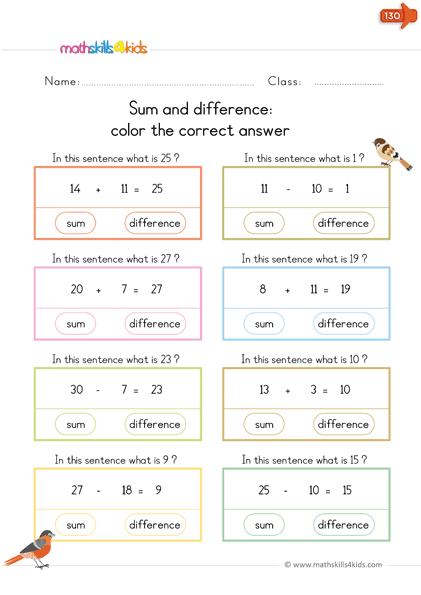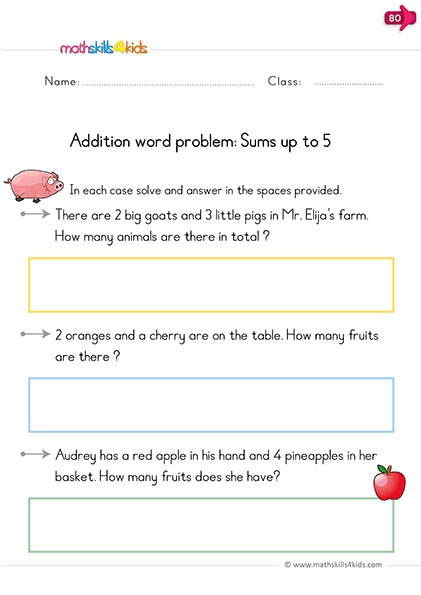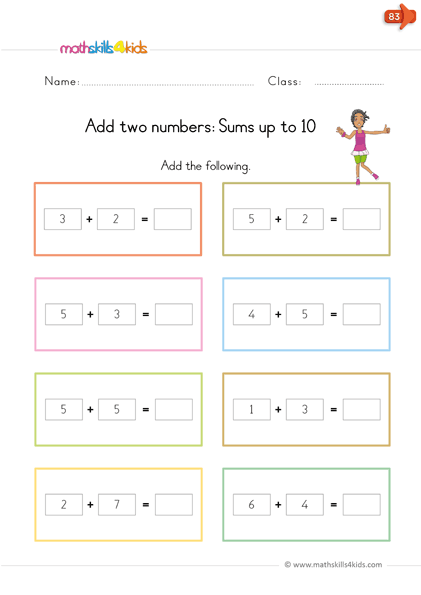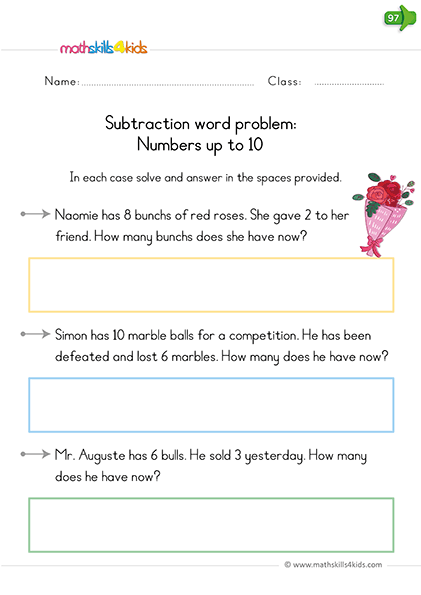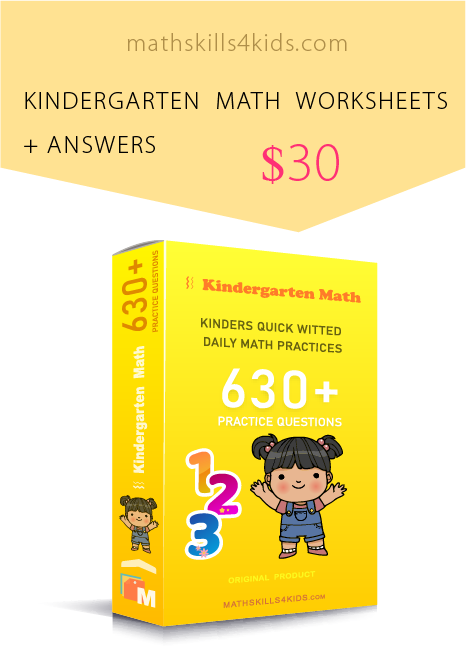Sum and difference: Kindergarten addition and subtraction worksheets
Hello, parents and teachers! Are you looking for fun and engaging worksheets to help your kindergarten students learn the basics of addition and subtraction? If so, you've come to the right place! In this resource, we will share some of the best worksheets created to ensure that kids learn and master how to find the sum and difference of numbers up to 10.
These worksheets cover the following topics:
-
- Introduction: Why learn addition and subtraction?
- Adding One More: How to count on using fingers or objects.
- Taking One Away: How to count back using fingers or objects.
- Making Ten: How to use ten frames and number bonds.
- Adding and Subtracting Within Ten: How to use strategies and facts.
- Word Problems: How to read and solve simple stories.
- Review and Practice: How to check your understanding and skills.
Let's dive in and see what these worksheets are all about!
Introduction: Why learn addition and subtraction?
Before learning addition and subtraction, kids must note that they are the two most essential math skills they'll need throughout their lives.
Addition and subtraction are the foundation for other advanced math concepts, such as multiplication, division, fractions, decimals, and algebra. They also help students develop logical thinking, problem-solving, and reasoning skills.
However, by learning addition and subtraction, your students will be able to:
- Compare quantities and find differences
- Combine groups and find totals
- Separate groups and find remainders
- Create patterns and sequences
- Measure length, weight, time, money, and more
That's why it is essential to introduce these skills early on and provide plenty of practice opportunities for your students. The worksheets that we'll show you will help you do just that!
-
BROWSE THE WEBSITE
-
DOWNLOAD FREE WORKSHEETS
-
-
K- MATH TOPICS
- Learn to count up to 3
- Counting from 1 to 5
- Count up to 10
- Learn to count up to 20
- Counting to 100
- Skip counting
- Measurement
- Sum and difference
- Comparison
- Patterns
- Addition up to 5
- Addition up to 10
- Subtraction up to 5
- Subtraction up to 10
- 2D shapes
- Introduction to symmetry
- Position
- Fractions
- Time
- Classify
- Data and graph
- Probability
- 3D shapes
-
-
Important facts about sums and differences math skills for kinders
A perfect understanding of “sum” and “difference” will eventually evade the confusion most young learners face when they begin to solve basic addition and subtraction word problems.
Math signs: add and subtract are first, basic and fantastic tools that ease communication between a given question and the person to solve. This unspoken or sign language will bring about an immediate understanding that;
- The “+” (plus) sign means adding one number to another, while
- The “-” (minus) sign means subtracting one number from another
However, as we put much prominence for kids to understand the meaning of the plus (+) and the minus (-) signs in our addition and subtraction worksheets for kindergarten, we are preparing their minds to seeing more math signs such as x, ÷, ˃, ˂, and many others.
But first things first, let us go to see how the math signs: add and subtract will enhance knowledge of sum and difference in kids.
-
Understand addition and subtraction signs – reinforce knowledge of sum and difference
It is of vital importance for kids to understand addition and subtraction signs at an early age. In fact this is one of the most basic achievements to success in math concepts.
As an essential fact, we need to also note that these add and subtract signs immensely reinforce knowledge of sum and difference. It is however evident that when we add and/or subtract numbers, we expect to obtain an answer or a result. These results or answers are usually termed sum and/or difference respectively. So following the signs below, let’s see clearly their differences;
- The answer to a + sign or addition sentence is called sum, whereas
- The answer to a – sign or subtraction sentence is called difference.
In other words,
- number1 + number2 = sum
- number1 – number2 = difference
The importance of our sum and difference worksheets lies on the fact that kids are being trained to easily understand basic word problems. Some of which include
“What is the sum of 2 and 3 ?” Here, you’ll be surprised to see that your kid will understand this to mean 2 + 3. So the sum is 5.
Also, “find the difference between 7 and 4”, which means 7 – 4. So, the difference is 3
As we now move to our exercises, it will be easy for us to tell which number is the sum and which is the difference.
-
Adding one more: How to count on using fingers or objects ?
One of the first steps in learning addition is understanding the concept of adding one more. This means finding the next number in a sequence by counting on from a given number. For example;
If we start with 3 and add one more, we get 4.
If we start with 7 and add one more, we get 8. And so on.
To help your students master this skill, you can use these worksheets that require them to count on using their fingers or objects. For example;
In this worksheet, your students have to look at the picture of a flower pot with some flowers and count how many flowers there are. Then they must draw one more flower in the pot and write the new number.
This worksheet is great for developing students' one-to-one correspondence, number sense, and fine motor skills. It also helps them practice writing numbers correctly.
-
Taking one away: How to count back using fingers or objects ?
Another essential skill in learning subtraction is understanding the concept of taking one away. This means finding the previous number in a sequence by counting back from a given number.
For example,
- if we start with 5 and take one away, we get 4.
- If we start with 9 and take one away, we get 8. And so on.
To help your students master this skill, you can use these worksheets that require them to count back using their fingers or objects. For example;
In this worksheet, your students have to look at the picture of a plate with some cookies and count how many cookies there are. Then they must cross out one cookie from the plate and write the new number.
This worksheet is great for developing students' one-to-one correspondence, number sense, and fine motor skills. It also helps them practice writing numbers correctly.
-
Making ten: How to use ten frames and number bonds ?
One of the key strategies in learning addition and subtraction is to make ten. This means finding pairs of numbers that add up to ten or finding how many more are needed to make ten from a given number. For example; 3 + 7 = 10 nbsp; or 10 - 7 = 3.
Making ten helps students understand the relationship between numbers and makes memorizing math facts easier.
To help your students master this skill, you can use these worksheets that require them to use ten frames and number bonds. A ten frame is a grid of ten squares that can be filled with counters or dots to represent numbers. A number bond is a diagram that shows how a number can be split into two parts. For example;
In this worksheet, your students have to use a ten-frame to show how many red and green apples are in a basket. Then they have to write a number bond to show how the total number of apples can be split into two parts.
This worksheet is great for developing your students' visual-spatial, mental math, and fact fluency skills. It also helps them practice writing equations correctly.
-
Adding and subtracting within ten: How to use strategies and facts ?
Once your students have learned the concepts of adding one more, taking one away, and making ten, they are ready to move on to adding and subtracting within ten. This means finding sums or differences of two numbers between zero and ten. For example, → 4 + 5 = 9 or 9 - 5 = 4.
To help your students master this skill, you can use these worksheets that require them to use strategies and facts. Strategies are methods or tricks that help students solve problems faster or easier. Facts are basic math facts that students should memorize for quick recall. For example;
In this worksheet, your students have to use the strategy of doubles (adding two numbers that are the same) or near doubles (adding two numbers that are one apart) to find sums within ten. Then they have to write the corresponding facts.
This worksheet is great for developing your students' critical thinking skills, mathematical reasoning skills, and fact fluency. It also helps them practice writing equations correctly.
-
Word problems: How to read and solve simple stories ?
Another essential skill in learning addition and subtraction is to read and solve word problems that involve adding or subtracting quantities or finding missing parts. These addition and subtraction word problems are simple stories that stimulate kids to understand and quickly find the sum or difference easily.
For example,
"Anna has 3 dolls. She gets 2 more dolls for her birthday. How many dolls does she have now?"
or
"Ben has 10 pencils. He gives some pencils to his friend. Now he has 6 pencils left. How many pencils did he give away?"
To help your students master this skill, you can use these worksheets that require them to read and solve word problems.
This worksheet is great for developing your students' reading comprehension, mathematical language, and problem-solving skills. It also helps them practice writing equations correctly.
Review and practice: How to check your understanding and skills ?
The last topic we want to share is review and practice. Review and practice are essential to learning any skill, especially math skills. They help students consolidate their knowledge, identify strengths and weaknesses, and prepare for assessments.
So why not use our kindergarten addition and subtraction worksheets to check your kid's understanding and skills each time after teaching a particular topic?
However, to help your students review and practice their addition and subtraction skills, you can use these worksheets from MathSkills4kids that cover all the topics we have mentioned. For example;
In these worksheets, your students must complete various tasks involving adding one more, taking one away, making ten, adding and subtracting within ten, and solving word problems.
Our worksheets are great for assessing students’ understanding and skills, providing feedback, and reinforcing learning.
Thank you for sharing the links of MathSkills4Kids.com with your loved ones. Your choice is greatly appreciated.
Useful links
12 Strategies on How to teach Addition and Subtraction in Kindergarten | mrswillskindergarten.com :
https://mrswillskindergarten.com/how-to-teach-addition-in-kindergarten/Addition and subtraction | Kindergarten | Math | Khan Academy :
https://www.khanacademy.org/math/cc-kindergarten-math/cc-kindergarten-add-subtract -
We hope you enjoyed reading this article and found it helpful in teaching your kindergarten students addition and subtraction. If you want to download these MathSkills4kids worksheets, use the link below each image you see, and access hundreds of high-quality math resources for all grades and levels.
Happy learning!
